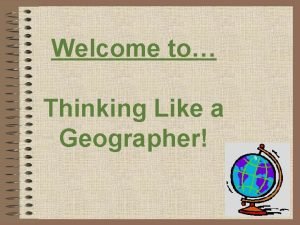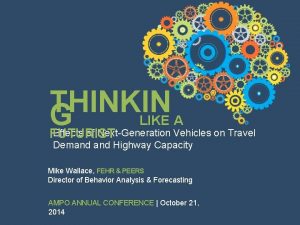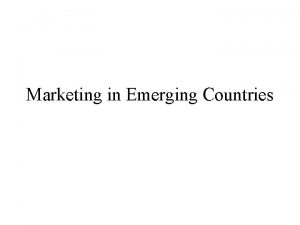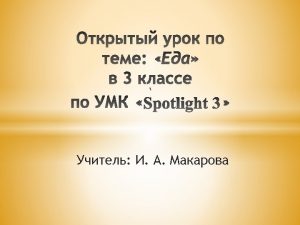Module 3 Think Like a Futurist The Emerging














- Slides: 14

Module 3: Think Like a Futurist The Emerging Future: Technology Issues and Trends ↗

Resources, Resources Module 3: Think Like a Futurist ↗ ↗ ↗ ↗ Terms and Definitions History of Futures Studies Notable Futurists Futurist Careers Futurist Organizations Interview with a Futurist General Resources

Goals and Objectives GOAL: Participants' overall goal is to gain a solid working knowledge of futures studies and what it means to think like a futurist. When you complete the course, you will know: ↗ ↗ ↗ ↗ what futurism is, a brief history of how futurism/futures studies came about, a number of key terms associated with futurism and their definitions and applications, numerous processes and methodologies employed when making forecasts, notable futurists within the field worth knowing about, available and probable futurist-type careers along with their characteristics and qualifications, and know where to find pertinent information about organizations, conferences, and other valuable resources to use in your future studies. Objective 1: Participants will be able to identify and understand a number of futuring methodologies, with which process they may work the best, and how they can be combined and applied for maximum strategic effect. ↗ Read and review the futuring methods listed in the Terms & Definitions section and discover several that appeal to you. ↗ Explore the resources to gain an understanding of what those methods are, what they can do and how to use them in a futures forecast. Objective 2: Examine and develop a basic understanding of the various techniques/processes used by futurists to plan for change. ↗ Once you have a firm understanding of those processes that appealed to you as listed in the Terms & Definitions section, you should be able to evaluate them and determine which ones are the most appropriate for personal or professional forecasting considerations. Objective 3: Participants will learn about a number of notable futurists. After reviewing the material, you will understand how diverse futurists and their backgrounds and philosophies and approaches truly are. ↗ Upon exploring several Noted Futurists, you should begin to grasp how they conduct their forecasts and their major areas of focus. Objective 4: Read and review the Futurist Careers section to learn what some believe will be the careers of the future. You will then be able to point out what major concepts and rational are behind many futurist careers. ↗ Evaluate what you discovered from the Futurist Careers section, then think about some of the positions you have seen recently or in the recent past ↗ Compare the various attributes of the positions you discovered to ones you know of today. Objective 5: Participants will be able to recognize significant historical people, places, and futuring terms and definitions that were and are crucial to the ongoing development of futures studies. ↗ Once you have reviewed as many of the resources that you found interesting, test and solidify your understanding in the Think Like a Futurist Quiz.

To Earn a Badge for Module 3 ↗ A posting and two responses to both Discussion Topics: ↗ Futuring Processes and Methods ↗ Notable Futurists, AND ↗ Completing the Think Like a Futurist Quiz (passing grade of 70%) HINT: Answers are embedded in this presentation

What is a futurist? Module 3: Terms and Definitions ↗ Association of Professional Futurists http: //www. profuturists. org/futurists ↗ ↗ ↗ A futurist uses foresight to describe what could and perhaps should happen in the future. Forecasts are made by using five processes: ↗ Framing ↗ Scanning ↗ Describing ↗ Planning ↗ Visioning Scanning involves studying the broad trends shaping our world using the acronym “STEEP” to categorize information ↗ Society ↗ Technology ↗ Economic ↗ Environmental ↗ Political

Futurist Planning Techniques Terms and Definitions: Module 3 ↗ Sohail Inayatullah: Six Pillars of Futures Studies ↗ For-Learn: Excellent Online Guide ↗ http: //www. profuturists. org/futurists ↗ ↗ ↗ ↗ ↗ Environmental Scanning & Monitoring SWOT Analysis Modeling & Simulation Gaming Expert Panels Delphi Methods Backcasting Roadmapping Scenario Building

Recommended General Resources Module 3 Resources ↗ Interesting Facts about Futures Studies ↗ University of Houston was the first to offer a program in the U. S. in futures studies or foresight in 1975. ↗ 2014 Pew Research Center and Smithsonian Magazine survey on U. S. views of technology and the future found that 51% of adults think that computers will be able to create works off art better than humans within the next 50 years.

Noted Futurists: Module 3 Noted Futurists ↗ Satwant Kaur: The “first lady of emerging technologies” and currently serves as HP Chief Technologist, author, keynote speaker. Wrote the book, Transitioning Embedded Systems to Intelligent Environments: A Journey Through Evolving Technologies. ↗ Lists of Noted Futurists to Explore

Resources to Check-out ↗ Giaoutzi and B. Sapio (eds. ), Recent Developments in Foresight Methodologies Complex Networks and Dynamic Systems 1, DOI 10. 1007/978 -1 -4614 -5215 -7_1, © Springer Science+Business Media New York 2013 ↗ Introduction ↗ Chapter 5: New Emerging Issues and Wild Cards as Future Shakers and Shapers ↗ Chapter 14. Scenario Planning as a Tool in Foresight Exercises: The LIPSOR Approach ↗ Chapter 15: Foresights, Scenarios, and Sustainable Development: A Pluriformity Perspective ↗ Futurefest: http: //www. futurefest. org/video/# ↗ For-Learn: http: //forlearn. jrc. europa. eu/guide/4_methodology/methods. htm

Technology Forecasting Methods ↗ ↗ ↗ Polling: Consulting with Experts ↗ Groups ↗ Delphi Method Gaming: Simulate different functions Models and Simulations ↗ Physical models ↗ Mental models ↗ Experiments ↗ Computer modeling ↗ Visioning (1962, Robert Jungk) Future Workshops ↗ Preferred Futuring (Apollo Space Program, Edward Lindaman) ↗ Develop a “preferred future vision” ↗ Use vision in planning process ↗ Goals ↗ Action Plan ↗ Infrastructure for plan

Backcasting ↗ Method credited to John Robinson, 1982. ↗ Robsinson, John. 1990. “Futures Under Glass: A Recipe for People Who Hate to Predict, ” Futures October. ↗ Reverse Engineering: Start with future vision and work backwards to insure goals and objectives are met. ↗ Develop normative scenarios and explore their feasibility and implications. ↗ Normative=one or two future scenarios that would be beneficial ↗ http: //www. naturalstep. org/backcasting ↗ http: //www. wfs. org/blogs/thomas-frey/future-favors-bold-%E 2%80%93 -8 backcasting-scenarios-for-understanding-future

Additional Resources: ↗ International Think Tanks and Other Organizationshttp: //forlearn. jrc. europa. eu/guide/A 2_refer ences/index. htm ↗ May 2014 Release: Library-based Future Scenarios: Jeffrey Schnapp and Matthew Battles, The Library Beyond the Book, http: //jeffreyschnapp. com/the-library-beyond-thebook/ Challenge to develop a list of changes libraries can make in the short-term and future to embrace technology and engage the community.

Minnesota Library Futures Initiative Scenarios: ↗ http: //mnlfi 2025. org/toolkit/scenarios/ ↗ 1. Most books are available digitally ↗ 2. Most patrons have a smart device they use to access content ↗ 3. The majority of scholarly information is open ↗ 4. Google Books (or some other private-sector platform) is the major way users discover, access, and read books ↗ 5. Communities, governments, other institutions merge due to ongoing budget declines ↗ 6. Nearly all people need digital media skills ↗ 7. Libraries balance the needs of graying populations with the needs of “born digital” generations 8. Patrons come to the library to create content and try out the latest technology ↗ ↗ 9. Digital rights allow libraries to provide patrons with seamless access to ebooks/other digital content 10. Patrons can move between libraries at school(s), work, and/or home seamlessly, with a consistent online experience ↗ 11. Libraries are more interconnected than ever before with new partnerships between libraries and with non-library organizations. ↗ 12. Libraries of all types have clear and consistent marketing messages ↗ 13. Libraries provide space more so than collections ↗ 14. Libraries are a place where users can learn from other people in face-toface interactions ↗ 15. Libraries continue to provide quiet study spaces while accommodating a variety of more active uses ↗ 16. People come to the library to disconnect from lives lived largely online ↗ 17. Partnerships and seamless referral to specialists allow libraries to take reference inquiries much further ↗ 18. School libraries are a mandated part of the curriculum and are key sources of information literacy education ↗ 19. Many schools have eliminated school libraries/librarians ↗ 20. Libraries design library software, publish and manage content, and share these creations with wider community

In the end… ↗ Various methods involved in forecasting, futuring, foresight, backcasting, planning for the future. ↗ Many types of forecasters in many disciplines ↗ Check Out the Resources
 Medical futurist
Medical futurist The art of noise futurist manifesto
The art of noise futurist manifesto Think big think fast
Think big think fast A little bird by aileen fisher
A little bird by aileen fisher Think fam think
Think fam think C device module module 1
C device module module 1 Girl scout volunteer toolkit
Girl scout volunteer toolkit Read like a historian
Read like a historian Think like a researcher
Think like a researcher Whats a geographer
Whats a geographer Các châu lục và đại dương trên thế giới
Các châu lục và đại dương trên thế giới Thế nào là hệ số cao nhất
Thế nào là hệ số cao nhất Hệ hô hấp
Hệ hô hấp Tư thế ngồi viết
Tư thế ngồi viết đặc điểm cơ thể của người tối cổ
đặc điểm cơ thể của người tối cổ



























